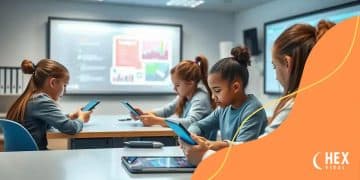Educating in the Metaverse: opportunities for growth

Educating in the Metaverse leverages immersive technology to enhance learning experiences, providing personalized education, global collaboration, and engaging gamified content while fostering essential social-emotional skills.
Educating in the Metaverse opens up a new frontier for learning, offering immersive experiences that traditional classrooms can’t match. Have you considered how this technology might transform education for students of all ages?
Understanding the metaverse’s educational landscape
In today’s rapidly evolving digital world, understanding the metaverse’s educational landscape is essential. The metaverse offers a unique environment where education can thrive through immersive experiences. This new approach to learning not only captivates students but also enhances their comprehension and retention.
What is the Metaverse?
The concept of the metaverse encompasses a collective virtual shared space created by the convergence of virtually enhanced physical reality and persistent virtual reality. Imagine a classroom filled with students from different parts of the globe, all interacting in real-time through their avatars. This makes learning not just informative but also fun.
Benefits of Metaverse Education
As we delve deeper into the metaverse, several benefits become apparent. These advantages can transform the way we approach education:
- Enhanced engagement through immersive experiences.
- Access to a broader range of resources and learning materials.
- Opportunities for collaboration across distances.
- Personalized learning paths tailored to individual needs.
These elements foster not only interest but also a deeper understanding of complex subjects. Moreover, the technology used in the metaverse allows for real-time feedback and assessment, which is invaluable for educators. Immediate insights into a student’s grasp of the material enable tailored interventions that keep learners on track.
Challenges Ahead
While the opportunities are promising, the metaverse also presents challenges. Accessibility and equity are pressing issues that require attention. Not all students have access to the necessary technology, which can create a divide in educational opportunities. Furthermore, ensuring a safe and inclusive environment in virtual spaces is paramount.
As educational institutions begin to adopt these innovations, they must be aware of these challenges and strategize accordingly. Developing comprehensive policies and training teachers in metaverse tools will be crucial to realizing the full potential of this educational revolution.
Key opportunities in metaverse education
Key opportunities in metaverse education can transform the way we learn and teach. With the ability to create immersive experiences, educators can engage students in ways never before possible. This technology promotes interactive learning, making it easier for students to absorb and retain information.
Immersive Learning Experiences
In the metaverse, students can journey into different environments, visualizing concepts in a tangible way. For instance, learning about the solar system can involve virtual space travel, where students explore planets firsthand. This hands-on approach makes education more relatable and exciting.
Collaborative Projects
The metaverse facilitates collaboration among students across the globe. They can work on group projects in shared virtual spaces, allowing diverse perspectives to shape their learning. The key benefits of this collaboration include:
- Enhanced teamwork skills.
- Exposure to different cultures and ideas.
- Improved communication abilities.
- Shared resources that expand knowledge.
This collaborative process fosters a sense of community among learners, further engaging them in their educational journey. In addition, educators can simulate real-world challenges, encouraging students to think critically and find solutions together.
Personalized Learning Paths
Another opportunity is the ability to tailor education to individual needs. The metaverse allows for personalized learning paths based on each student’s skills and learning pace. Teachers can track progress in real-time and adjust the curriculum accordingly. This adaptability helps ensure that every student reaches their potential.
Furthermore, by incorporating gamification elements, students may feel more motivated to participate. Learning becomes a fun activity rather than a chore, resulting in a greater retention of information.
Potential challenges and limitations

As we explore the potential challenges and limitations of education in the metaverse, it becomes clear that while the opportunities are plentiful, obstacles exist that need addressing. Ensuring equitable access to technology is a major concern. Not all students have the devices or high-speed internet needed to engage in virtual learning environments.
Technological Barriers
Many students still face barriers when it comes to technology. Some key issues include:
- Lack of access to VR hardware.
- Inconsistent internet connectivity in certain regions.
- High costs associated with necessary devices and subscriptions.
These factors can lead to a digital divide, where only some students can fully participate in metaverse education, thus hindering inclusive learning.
Safety and Security Concerns
Another significant challenge involves ensuring the safety and security of students in virtual environments. Cyberbullying and inappropriate content are serious issues that educators must manage. Schools must develop clear guidelines and policies to protect students from potential dangers.
Furthermore, teaching digital citizenship is essential. Students need to understand how to navigate these environments responsibly. This includes knowing how to interact respectfully and recognizing the importance of privacy.
Teacher Training and Preparedness
For metaverse education to be effective, educators must be well-prepared. Not all teachers are familiar with virtual platforms and technologies. There is a need for comprehensive training programs that equip teachers with the skills to facilitate engaging metaverse lessons.
Moreover, ongoing support is crucial as technology continues to evolve. This means schools should provide resources for teachers to learn and adapt to new digital tools and methodologies continuously.
Success stories in metaverse learning
Exploring success stories in metaverse learning reveals the immense potential this technology offers to educators and students alike. Several schools and institutions have already adopted methods that leverage the metaverse to enhance educational experiences.
Case Study: Virtual Science Expeditions
One remarkable example is the use of virtual science expeditions. Schools have taken students on immersive trips to places like the Amazon rainforest or the depths of the ocean. These experiences allow students to observe ecosystems up close, fostering a connection to subjects that traditional classrooms may struggle to convey.
Feedback from students has been overwhelmingly positive, showing increased interest and enthusiasm for science topics. This engaging method not only makes learning fun but also deepens their understanding of complex concepts.
Global Classrooms
Another compelling success story comes from the creation of global classrooms in the metaverse. Students from different countries can collaborate on projects in real-time, sharing their unique perspectives and cultures. This collaborative approach promotes:
- Greater cultural awareness.
- Improved language skills through interaction.
- Innovative problem-solving as diverse ideas merge.
In these online environments, students participate in real-world simulations, tackling global challenges while building meaningful connections with peers worldwide.
Personalized Learning Journeys
Some educational programs utilize the metaverse to offer personalized learning journeys tailored to each student’s needs. For example, students struggling with math can embark on engaging, interactive quests that allow them to practice skills at their own pace. They receive instant feedback, which helps reinforce concepts effectively. Many educators note significant improvements in student performance and confidence as a result of this tailored approach.
These success stories highlight the transformative power of the metaverse in education, paving the way for a future where learning is more inclusive, engaging, and effective for all students.
Future trends of education in the metaverse
Analyzing the future trends of education in the metaverse reveals exciting possibilities for students and educators. As technology continues to evolve, so does the way we learn and teach. The metaverse stands at the forefront of this transformation, promising innovative approaches to education.
Increased Use of AI
One key trend is the integration of artificial intelligence (AI) within the metaverse. AI can enhance personalized learning experiences by analyzing student data and adapting lessons to meet individual needs. This means that students can receive immediate feedback and support tailored specifically to them.
Growth of Hybrid Learning Models
Another trend is the growth of hybrid learning models that combine in-person and virtual experiences. These models allow students to benefit from direct teacher interaction while also exploring immersive environments online. This flexibility prepares them for future careers that may require both traditional and digital skills.
- Students gain broader world knowledge.
- Increased collaboration and teamwork skills.
- Enhanced engagement through varied learning environments.
With this approach, educators can create a rich and diverse learning landscape that caters to different learning styles and preferences.
Gamification in Education
Furthermore, gamification will play a pivotal role in making learning more engaging. Incorporating game elements into lessons can motivate students and make complex subjects simpler to understand. For example, students might complete quests, earn rewards, or participate in challenges within a virtual classroom environment.
This not only captivates their interest but encourages active participation, making education a more enjoyable experience. As gamification becomes increasingly prevalent, we can expect to see improved learner outcomes and retention rates.
Focus on Social-Emotional Learning
Lastly, the focus on social-emotional learning (SEL) will become more prominent in the metaverse. Educators will prioritize teaching empathy, teamwork, and emotional intelligence through collaborative projects and virtual interactions. These skills are vital in the 21st century and will help prepare students for success in the workplace.
By fostering a more comprehensive educational experience in the metaverse, students will emerge better equipped to navigate challenges in both their academic and personal lives.
As we look towards the future of education in the metaverse, it is clear that we are on the brink of a transformation in how learning takes place. The integration of technology will enhance the learning experience, making it more engaging and personalized for each student. While challenges remain, the opportunities for growth, collaboration, and innovation are immense. Embracing these changes will not only benefit students but also prepare them for a digital world that continues to evolve.
FAQ – Frequently Asked Questions About Education in the Metaverse
What are the main benefits of using the metaverse for education?
The metaverse enhances engagement, personalizes learning experiences, and allows for global collaboration among students.
How can AI be integrated into metaverse education?
AI can provide personalized feedback and adapt learning paths based on student performance, making education more tailored to individual needs.
What role does gamification play in the metaverse?
Gamification increases student motivation and makes learning interactive, allowing students to engage with content in a fun, game-like manner.
How does the metaverse promote social-emotional skills?
The metaverse fosters teamwork and empathy through collaborative projects and virtual interactions, essential for developing social-emotional intelligence.






